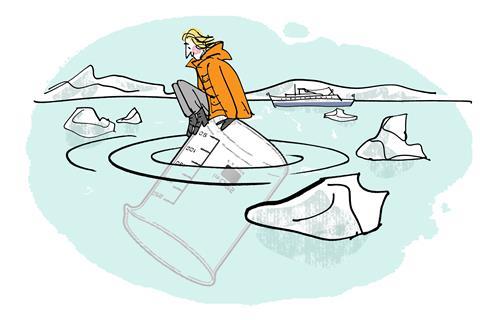Voyaging into the arts

Last year I was artist-in-residence on expeditions to Antarctica and the Canadian Arctic and Greenland, as well as aboard a ship crossing the Atlantic from Amsterdam to Quebec City.
Today, while digging through the old, tattered, yellowed, oily (and in places literally bloodstained) plans piled in the chief electrician’s cluttered office I discovered that the ship’s first name was Konstantin Simonov. Simonov was a Soviet-era Russian poet. How many ships are named after poets…?
My way into the arts was through poetry, via chemistry.
I completed a chemistry degree in 2013. After working various jobs for a few years, I started a PhD. This was when poetry invaded my life, upending it.
The ship is covered in devices that are designed to fall off if it sinks. A bit like a lizard – if a lizard’s dropped tail happened also to be a black box containing all that was measurable about that lizard’s life, or if on contact with water the tail became a high energy distress beacon, alerting nearby lizards.
In many ways a ship is more sophisticated than a lizard…
When people ask me how I got into poetry (or, how poetry got into me) I usually say that my notebooks, initially filled with equations and scratchy diagrams, filled up with words, until eventually I found myself writing poems. The truth is, I don’t really know how it happened. Post-hoc explanations are always a bit suspect, I think.
To learn more, I began reading poetry books. Initially it was a struggle to find anything I liked. Most of what the mainstream had to offer was, I felt, really boring.
I was looking for something different. I was excited by the possibilities of language. As a medium, I felt it had incredible potential: a poem could flash from internal reflections to the bleeding edge of theoretical physics and back to the kitchen table in the space of a single line, if it wanted to. I was searching for poems which reflected, vibrated with, that possibility.
Eventually I found what I was looking for.
Hovering flecked with white in motion the blue of the future. The rudder metamorphic swirls up the middle like the Arctic summer. Bunched language gets into me like a fuel tank. Making me paranoid. The hull bleeds… Unpaning the prow and the top of my head like ship corridors. The room lights up slopped with language… How terrifying it is being back in the deep with liquid morbid luck. An initial idea. The ghost below the waterline. The helm meets the resistance of my imagination… That’s all I remember. Will be sporadic. Walking down the street whisps turn my head…
These are excerpts from a text called Hyaloclastics, a heightened, dreamlike reimagining of my experiences. (Hyaloclasts are glass fragments formed by the quench fragmentation of lava during submarine or subglacial extrusions.)
Although I’m no longer a scientist, scientific language and thought continue to inform the work I do. But unlike a scientist, I now incorporate into my work the sights, sounds, smells, thoughts and so on, that for convenience and tractability are typically excluded from scientific models.
After almost two weeks at sea, a strangely comforting sight: seaweeds floating by. Hello, foreign friends… Little scummy strips and swirls of sea life - cells, eggs, algae - like dirty brown-green milky ways. My mind goes microscopic… What I think is kelp (leaf and trailing root) is bird and wake: it dives. A white wing detail about a metre under, catching the light. Then it’s gone… The water is calm enough to reflect the land. Which you wouldn’t know but for the ice: bright pillars on the water fading towards us…
The texts included in this article, as well as poems, photographs, collages, drawings, icemelt samples and various performances, including a planned choral score for 25 voices – all of which draw on my experiences during the above mentioned residencies – together form a large project-in-progress, the results of which my collaborators and I will begin sharing this year.
A change of tack! (I will never carelessly use a boating metaphor again.) The ship has an odd asymmetric layout: moving from port to starboard usually involves a longish detour. There are frequent dead ends, and unused (awkward-shaped) rooms… Some (all?) cetaceans have asymmetric skulls which I believe has something to do with sonar: a whale’s skull is like a dish for sound. Obviously the asymmetry of the boat has nothing to do with sound generation or reception (though each and every time a decent wave spanks the hull the whole ship reverberates) but I like the idea that we might resemble a whale cutting through the water in more ways than one: the crew in their bunks below the waterline, saturated in deep sea sound…












No comments yet